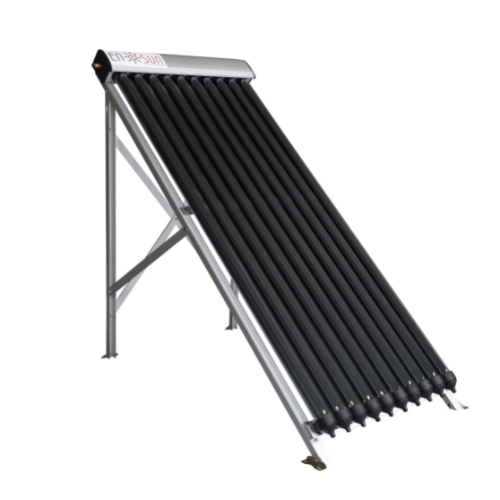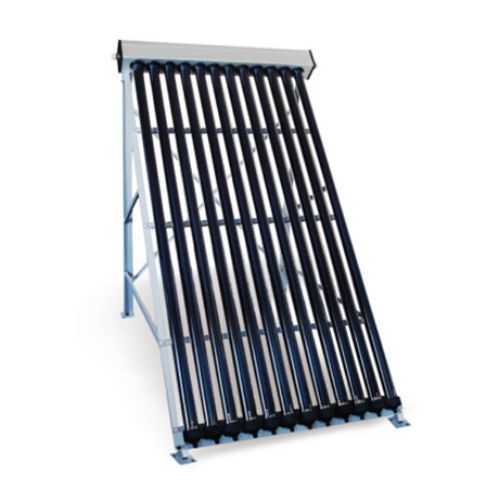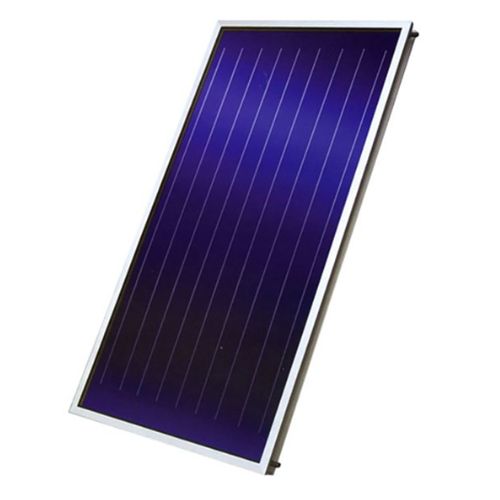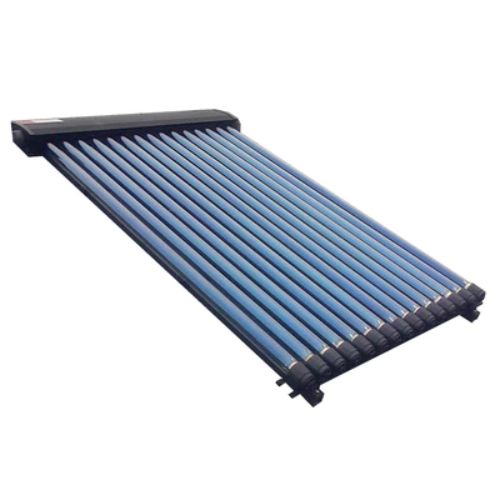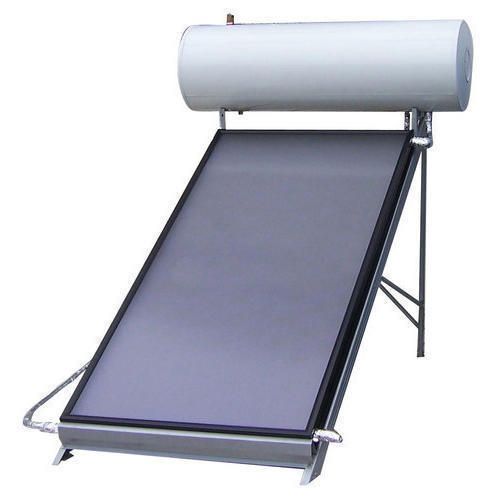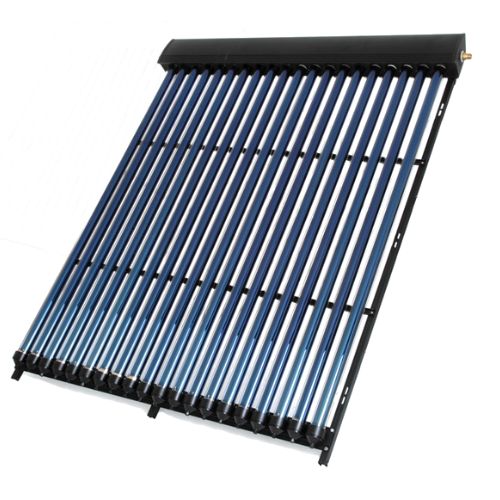Ensun - Solar Collector
Ensun solar collector is used to collect solar radiation from the sun. Active solar heating is the main application for these devices. It produces heat, which can be used to heat water, cook food, or produce electricity. These collectors are mounted on the roof. They are subjected to a wide range of weather conditions. Thus, solar collectors are made durable and of high strength. These are built with the same fundamental idea in mind. Its material and coating can enhance the absorption of solar energy.
At Ensun, you can discover a wide range of solar collectors. We manufacture heat pipes, evacuated tubes, flat plates, non-pressure solar collectors, and more. Each collector has its own features and advantages. You can choose the best one or we will recommend the right solution for your projects. Guaranteed safe, reliable, and high performance. Message us with your requirements.
Also known as Compound Parabolic Collector. Convenient to use, high-performance and non-imaging concentrators with a low concentration ratio.
In this device, the vacuum tube has a direct flow U pipe. Offer low-temperature resistance, no water inside the vacuum tube, and low maintenance.
Heat pipe solar collectors absorb solar radiation energy via a heat pipe evacuated collector tube. Energy-saving equipment with large high output temperature.
Flat plate solar collectors are consisted of copper pipes are bonded, brazed or soldered. It guaranteed maximum surface contact and heat transfer.
Non-pressure solar collector has no storage water tank, just a manifold. It is utilized for a large-scale commercial solar water heating project.
Features evacuated tubes and heat pipe. It can contribute to saving of up to 50% of your electricity. Made with high durability and longevity.
Why Choose ENSUN Solar Collector?
Ensun has 10+ years of manufacturing solar collectors. We use quality materials and components for production. It includes high-grade aluminum for manifold casing and frame material. All are inspected before being delivered and packed at a high-quality level. They are compliant with CE, ISO, SGS certification, and more. Thus, guarantee you can receive high-end solar collectors at the best price.
Our team also supports OEM services. We will help you on the logo design, package design, installation manual design, water tank design, etc. Our professionals will walk you through the entire process.

Related Product
Solar Collector – The Ultimate FAQ Guide
Solar collectors operate under the principle of maximizing solar energy absorption and conversion into another form usually thermal or electrical. Solar collectors find use in residential, commercial, and industrial settings as a green alternative with lower costs and reduced carbon emissions.
What is a Solar Collector?
A solar collector is an integral solar energy system component used to capture and convert sunlight into useful thermal or electrical energy.
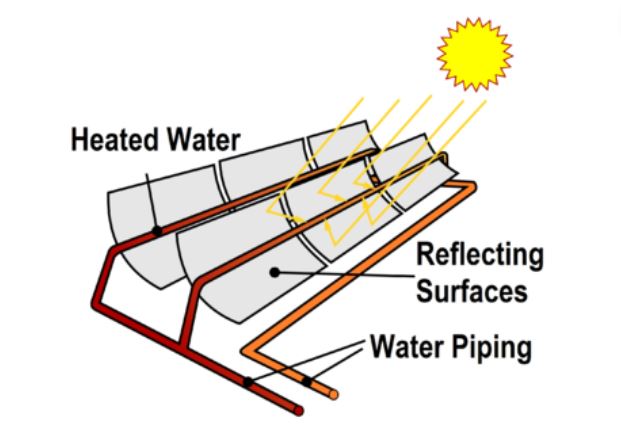
Advantages of Solar Collector
There are many variables that determine effectiveness of solar collector systems. These include location, system design, and climate, just to mention a few.
Even so, solar collector offer many advantages such in today’s domestic and industrial setups.
Some of the advantages include:
How to DIY your solar collector water heater?
Solar collector water heater is one of the main products of Kesun Solar. It is widely used in North Europe. Solar collector water heaters normally consist of a heat pipe solar collector, hot water boilers, pump stations, controller, and expansion vessel.
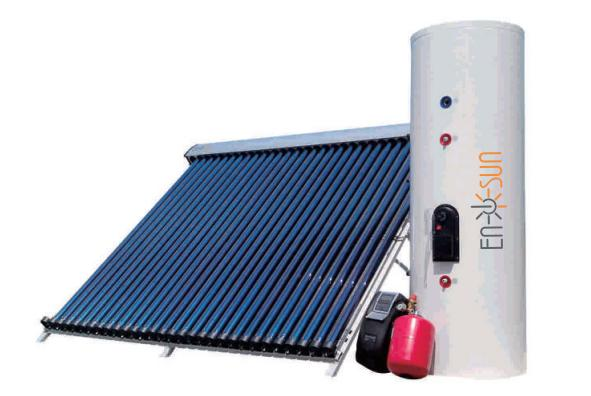
The heat pipe solar collector can be integrated with architecture perfectly. And also can be installed in garden which will not cost the space of your house roof.
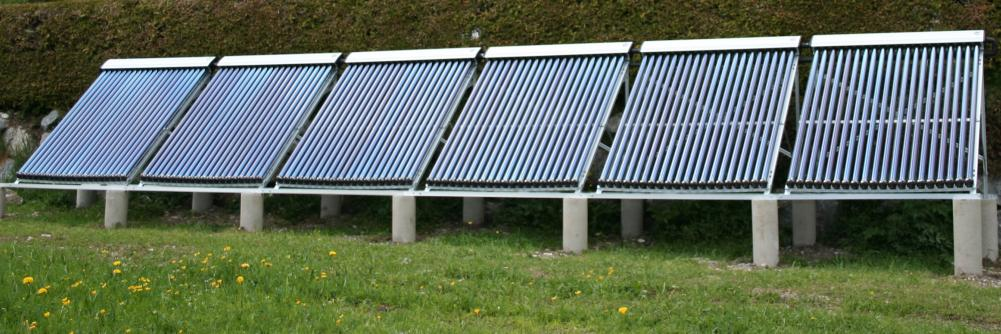
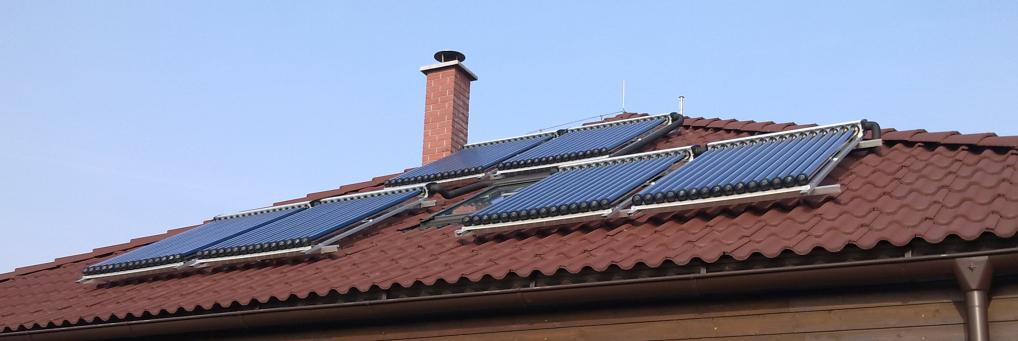
You can check the working principle of the solar collector water heater below. The solar collector absorbs the sunshine and converts it into heat energy. Heat energy will be transferred to the water tank by the medium liquid inside the piping. The liquid is circulated by the pump when there is heat energy available from the collector. According to the requirement, you can DIY the solar collector water heater.
— For shower purposes, You need to consider a 50L capacity for each person. If you have 5 person family, then you will need a 250L hot water boiler. 25 tube heat pipe solar collectors will be needed for the 250L hot water boiler.
–For shower and room heating purposes, you need to think about an extra boiler for energy storage of heating. And then extra collectors will be needed. Also the three-way valves. First, heat the shower boiler to a reasonable value and then the three-way valve will switch the energy to the heating boiler.
For more questions, welcome to contact with Kesun sales manager.

Cost Savings
Solar collectors offer long term cost savings despite the initial installation cost being considerably higher than traditional energy systems. Heating and cooling needs are some of the largest contributors to power bills and using solar collectors instead greatly intervenes.
Multiple Usage
Solar collectors can support several applications for both domestic/household and industrial usage making it highly versatile. Such systems are utilized for water heating, air conditioning and electricity generation.
Grid Stability
Solar collectors reduce dependence on external energy sources allowing communities, individuals and businesses to independently generate electricity or heat. This is useful in offering grid stability especially in off-grid or remote areas with limited or inconsistent access.
Environmentally Friendly
Solar collectors produce clean energy. Consequently, using solar collectors is environmentally friendly helping combat the negative impact of pollution.
Modular and Scalable
There are several sizes of solar collectors fit for small scale usage like homes or large scale use like industries. You can also scale solar collectors up or down according to your energy needs.
Durable
Solar collectors are functionally durable capable of offering decent performance for years without failure. Requiring with proper installation and maintenance, they can continue to operate efficiently for several decades.
Low Maintenance
The maintenance needs of solar collectors are generally lower compared to conventional energy systems. Their lack of moving parts reduces risk of mechanical failure requiring only routine inspections and cleaning for optimal performance.
Renewable Source
Solar collectors utilize solar energy which is a renewable source of energy i.e. it is virtually limitless and available unlike fossil fuels.
Limitations of Solar Collector Panels.
Solar collector panels remain a promising and increasingly viable option for sustainable energy generation.
Some of these limitations include:
Dependence on Sunlight
Solar collectors rely on sunlight as their primary energy source and are thus most effective in areas with abundant sunlight. Therefore their efficiency reduces during certain times of the day, under cloudy conditions and during low sunlight periods such as winter.
Grid Integration
Integrating solar collector panels with the standard grid can be difficult stemming from solar energy’s intermittent nature. This affects grid stability requiring use of specialized grid management strategies and technologies alongside energy storage systems to stabilise supply.
Initial Cost
While solar collectors offer significant long-term cost reductions, initial installation costs are considerably high. The cost of acquiring the equipment to set up a solar collector system may discourage one form investing.
Intermittent Energy Source
Solar collectors utilize solar energy as their energy source limiting use to daytime only when the sun is present. While utilizing batteries for energy storage is an option, it is an extra cost that makes use of solar collectors limiting.
Limited Efficiency
Solar collectors have low efficiency in terms of sunlight conversion into usable energy 1.e. thermal or electrical. The efficiency of most solar collectors is around 20% making the conversion rate of sunlight to solar energy poor.
Space Requirement
Solar collector systems utilize large space requirements during installation given the size of equipment used. Consequently, you need sufficient space to meet your desired generation capacity, which is difficult especially for urban establishments low on space.
Types of Solar Thermal Collector
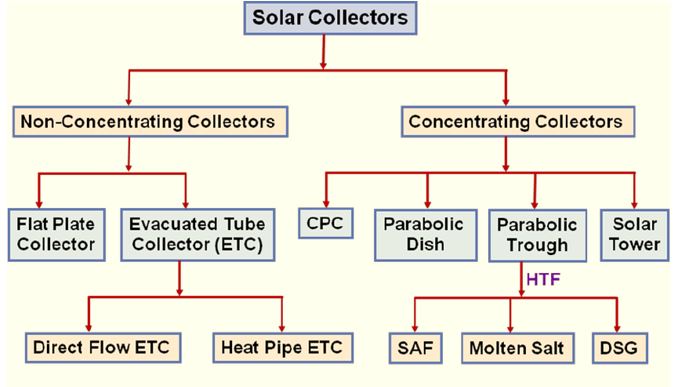
Non-concentrating Solar Collectors
Non-concentrating solar collectors are those whose collector/interceptor area is similar in size to the absorber area. The collector/interceptor area is where radiation is captured whereas the absorber area is where the energy is absorbed.
I. Flat Plate Collector
A flat plate collector encompasses one of the most popular solar collectors used to harness solar energy for heating purposes. The feature a collector positioned in a glass box with a horizontal pipe pairing interspersed with vertical pipes.
Parts
A flat plate collector will typically include the following parts:
- Absorber Plate: It’s a dark and flat panel constructed from thermally conductive material that converts absorbed solar radiation into heat.
- Transparent Cover: Usually glass or plastic, the cover shields the absorber plate allowing passage of sunlight and preventing collector heat loss.
- Insulation: Consists insulation material like fiberglass or foam on the absorber’s backside that helps prevent heat transfer to the surroundings.
- Fluid Passage: Consists of a pipe network attached to the absorber plate containing heat-transfer fluid that circulates and absorbs heat energy.
- Casing: Encloses the entire assembly providing structural support and protection against weather conditions.
Working Principle
The working of a flat plate collector takes the following form:
- Absorption: Sunlight strikes the cover to reach the absorber plate where the solar radiation is absorbed and converted it into heat energy.
- Heat Transfer: The absorbed heat is transferred to the circulating fluid which consequently increases temperature.
- Heat Removal: The heated fluid is conducted to the application area such as water heating typically through a heat exchanger.
Benefits
There are several benefits attached to utilising a flat plate collector as follows:
- Flat plate collectors have a relatively simple design, making them easy to manufacture and install and thus cost-effective.
- This solar collector type can be used for various heating applications e.g. water heating for homes, space heating, and pool heating.
- The design featuring a sturdy casing and robust absorber plate, ensures the collector can tolerate adverse weather conditions.
- Flat plate collectors can serve you for a long period without failure reliably and efficiently converting solar energy into heat.
Limitations
Some of the limitations associated with the flat plate collector include:
- Flat plate collectors work best when moderate-temperature heat is required and not nearly effective for generating high-temperature or cold conditions.
- The efficiency of flat plate collectors in capturing solar energy is typically lower compared to more advanced collectors.
- The performance can be affected by shading or accumulation of dirt/dust on the transparent cover.
- These collectors can experience some heat loss, especially at night or during colder weather conditions.
Applications
Flat plate solar collectors find use in various heating systems. Some common applications include:
- Solar Water Heaters: This type of solar collector is utilized in water heating in both residential and commercial applications.
- Space Heating: Space heating systems utilize flat plate collectors to warm air or water before circulation through the building.
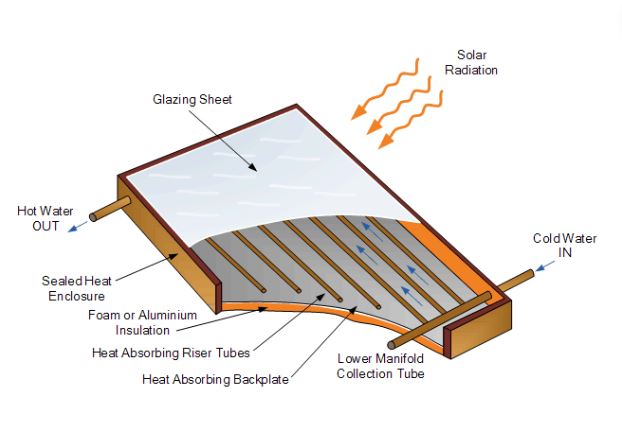
II. Evacuated Tube Collector
An evacuated tube collector employs several glass tubes to absorb solar radiation and convert this energy into heat energy. They find common use in water heating systems with different types available to achieve different performance and efficiency levels.
Types
You find the following primary designs of evacuated tube collectors:
i. Direct Flow Evacuated Tube Collector
Also referred to as U-pipe collector, it consists a pipe pairing functioning as inlet and outlet within the tube. The pipes are secured such that replacing them is difficult.
The efficiency of this solar collector is such that the fluid in the multiple tubes do not interact retaining more heat. Furthermore, does not require solar tracking to direct and trap solar energy.

ii. Heat Pipe Evacuated Tube Collector
In this design, the absorber plate is attached to a copper pipe and sealed within a solar tube. The copper pipe is hollow with the heat-transfer fluid contained within and with evacuated space.
Having an evacuated space makes it possible for heating to be undertaken at standard pressure conditions. Absorption of radiation boils the liquid in the pipes vaporizing it as it moves though the manifold.
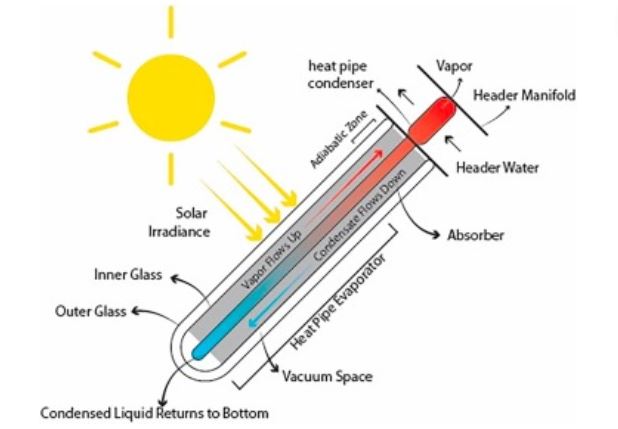
The heat energy is transferred via a heat exchanger to the area of application. The now cool liquid flows back to the absorber where the process is repeated.
Parts
The following parts are integral to an evacuated tube collector:
- Glass Tubes: This collector comprises several glass tubes that are transparent and parallel to each other. These tubes have both ends sealed and contains another tube, the absorber tube.
- Absorber Tube: Has a coating that is solar selective with high efficiency used in absorbing solar radiation with minimal loss of heat.
- Heat Pipe: The heat pipe is contained in the absorber tube and facilitates absorbed heat transfer to the fluid.
- Manifold: Connects the glass tubes and is the precise location where the heat exchange from the heat transfer fluid happens.
- Vacuum Insulation: The glass and absorber tubes are separated by a vacuum that insulates the system thereby reducing loss of heat.
Working Principle
The working of an evacuated tube collector takes the following form:
- The prices begins with the absorption of solar radiation by absorber tube’s selective coating. It then converts this radiation into heat energy transferring it to the heat pipes.
- The heat-transfer fluid in the U-tubes absorbs this heat carrying it to the heat exchanger. Here, the heat is removed from the fluid for use in heating applications e.g. water heating.
Benefits
The advantages in employing this type of solar collector are listed below:
- By utilizing vacuum insulation, the heat loss experienced in this solar collector type is minimal compared to other collectors. As such, it also works better in colder and cloudy conditions.
- Evacuated tube solar collectors have greater efficiency in retaining heat thanks to their use of selective coating and vacuum insulation.
- The design of the evacuated tube solar collector is such that the tubes are not easily damaged making them durable.
- These solar collectors can serve various applications like both domestic and commercial water heating, air and pool heating.
- You can add more tubes to increase capacity and thus scale of use.
Limitations
There are a few limitations associated with the evacuated tube solar collector as follows:
- When compared to other solar collectors, this type is considerably costlier owing to its design and features.
- Installing this solar collector is not straightforward and may require a professional to ensure proper installation and thus functionality.
Applications
Evacuated tube solar collectors have a wide range of applications, primarily in solar thermal energy thanks to their performance efficiency. Some of its common applications are:
i. Building Heating: These solar collectors can be integrated into building heating systems such as forced air conditioning systems and floor heating.
ii. Domestic Water Heating: Evacuated tube solar collectors find use in both residential and commercial hot water systems reducing grid dependence.
iii. Industrial Process Heating: Several industrial applications requiring heat like drying processes can implement these solar collectors.
iv. Pool Heating: Swimming pools can utilize solar energy captured by evacuated tube solar collectors to heat their water.
Concentrating Solar Collector
A concentrating collector system utilizes reflective surfaces or some optical element to focus sunlight onto a reduced surface area. Such a concentration makes it possible to capture higher temperatures and thus greater energy as compared to non-concentrating collectors.
I. Compound Parabolic Concentrator
A compound parabolic concentrator utilizes a specified geometric shape to concentrate the radiation. This improves efficiency in capturing sunlight during daylight and thus heating performance.
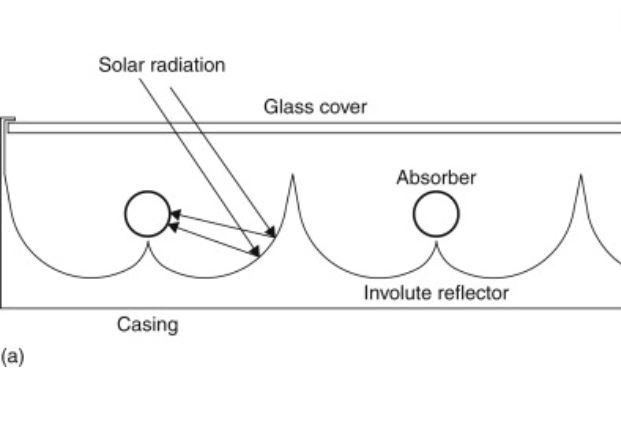
Parts
A compound parabolic concentrator will typically consist of the following:
- Reflector: The reflector is usually in a two-part compound parabolic shape with a curved section with tapering and non-curved part. This design allows effective sunlight capture at different angles by the concentrator.
- Aperture: It is the opening through which sunlight makes way into the collector typically rectangular or circular in shape.
- Receiver: Absorbs the concentrated sunlight via either a PV cell or heat transfer fluid before conversion into useful energy.
Working
A compound parabolic concentrator solar collector’s working can be summarized thus:
- Sun Tracking: A CPC system maximizes the capture of solar energy by tracking the sun to align it with the collector. Consequently, at any given time the system captures most sunlight.
- Capture and Concentration: The sunlight entering the CPC via the aperture is reflected multiple times by the reflective surface. It is then focused to the exit area thanks to the collector’s compound parabolic shape.
- Energy Conversion: The receiver absorbs the focused sunlight converting it into useful energy by employing heat transfer fluids or photovoltaic cells.
Benefits
The compound parabolic concentrator has the following benefits:
- The CPC’s unique shape allows for effective sunlight concentration increasing level of energy capture and efficiency in energy conversion.
- These have a wider acceptance angle allowing effective capture of sunlight no matter the position in the sky.
- Can be utilized in a wide range of applications from, water heating, building heating systems and solar thermal power generation.
Limitations
Some limitations of the compound parabolic concentrator include:
- While they achieve significant sunlight capture, they do not offer the best concentration ratio amongst concentrating solar collector systems.
- This solar collector type can only achieve moderate concentration ratios and thus not suitable for extremely high temperature needs.
Applications
Compound parabolic concentrators are an efficient alternative for concentrating solar energy. Their numerous advantages allow their use in various applications as mentioned below:
i. Concentrated Power Plants: These collectors can be used to make concentrated solar power plants for large scale electric generation.
ii. Process Heating: Compound parabolic concentrators can provide high-temperature heat for industrial processes like desalination.
iii. Solar Cooking: Can be utilized in setting up small scale cookers or ovens by concentrating sunlight onto enabling solar-powered cooking.
II. Parabolic Dish Solar Thermal Collector
A parabolic dish solar thermal collector utilizes a parabolic-shaped dish in concentrating sunlight onto a receiver. The unique design makes the solar concentration highly efficient capable of achieving high temperatures values.
Parts
The following parts typically make up the parabolic dish solar thermal collector:
- Parabolic Dish: Is the main part made of reflective material typically a reflective film or mirror designed to concentrate the sunlight.
- Receiver: Positioned at the dish’s focal point, it absorbs the concentrated sunlight converting it into useful energy. Depending on the application, it can be a solar cooker, heat exchanger or Stirling engine.
- Support Structure: Includes a tracking systems for optimized capture of solar energy and offers the parabolic dish structural support and alignment.
Working Principle
The following steps summarize the working of a parabolic dish solar thermal collector:
- The tracking system orients the parabolic dish with the sun ensuring solar energy capture is at maximum.
- The curvature of the parabolic dish reflects the sunlight it receives from all angles concentrating it onto the focal area.
- The focal point receiver absorbs the focused solar energy before converting it into useful energy depending on the application.
- When used for thermal application, the receiver is connected to a heat transfer fluid that absorbs the heat energy.
Benefits
There are several advantages in using a parabolic dish solar thermal collector:
- Scaling up or down of parabolic dish solar systems is possible allowing application in different settings depending on energy requirements.
- The concentration ratio in parabolic dish solar collectors is higher maximizing the amount of solar energy captured and converted.
- You can achieve high temperature values using parabolic dish solar collector thanks to its ability to concentrate sunlight.
- You can use the parabolic dish solar collectors for multiple applications such as water heating, electricity generation and cooking.
Applications
Use of parabolic dish solar collectors is present in the following applications:
i. Solar cooking systems can be configures by utilizing parabolic dish solar thermal collectors to concentrate solar energy for cooking and heating.
ii. Stirling engines can convert heat obtained from concentrated solar energy by parabolic dish collectors into mechanical energy used to produce electricity.
iii. This type of concentrated solar collector is suited for heat intensive industrial processes like thermal treatments and metal smelting.
iv. Water heating systems for residences and commercial spaces can utilize solar energy harnessed by these solar collectors.
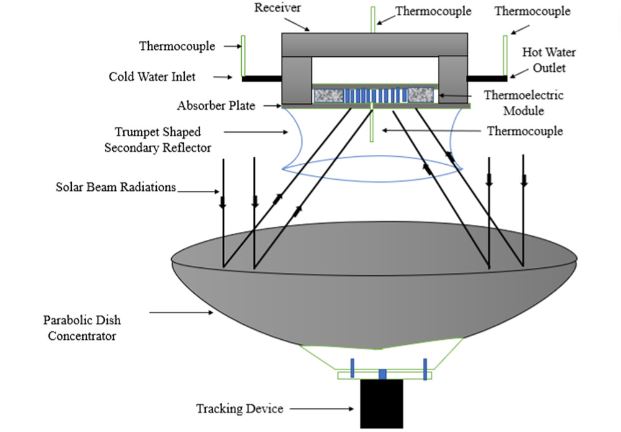
III. Parabolic Trough
A parabolic trough solar system is commonly utilized in large-scale solar power plants and features a reflector in a curved, parabolic shape. This reflector focuses sunlight onto a tubular receiver positioned on the line of focus allowing effective concentration.

Types
A parabolic trough can be utilized as a solar cooker where the sunlight is concentrated and used for cooking. It can also be used for thermal generation where a heat transfer fluid is run through channels within the focal line.
When utilized for the latter, there are three types of heat transfer fluid that can be used:
Synthetic Aromatic Fluids
This heat transfer fluid is designed to facilitate efficient absorption and transfer of thermal energy in concentrated solar collector systems. It offers low viscosity and freezing point displaying high thermal stability, and heat capacity.
Molten Salt
Consists of different salts melted and mixed together, resulting in a homogeneous liquid matter with high temperature stability. Its use as a heat transfer fluid for parabolic trough solar collectors is also supported by its heat storage capacity.
Direct Steam Generation
A parabolic trough utilizing direct steam generation refers to a configuration where the heat transfer fluid directly generates steam. As such, need for a heat exchanger is eliminated, with water commonly applied as the heat transfer fluid.
Parts
The design of a parabolic trough typically includes the following primary components:
- Parabolic Reflectors: Constitute long and curved reflectors with parabolic shape fashioned from highly reflective material. The parabolic shape ensures maximum capture of sunlight for concentration despite angle of incidence.
- Receiver Tube: The receiver/absorber tube is a metal or glass tube that is vacuum sealed located along the parabolic reflector’s focal line. It utilizes molten salt or thermal oil as a heat transfer fluid which absorbs the concentrated sunlight energy.
- Support Frame: Offers the reflectors and receiver tube structural support while responsible for adjusting and aligning the reflectors to the sun. It can employ both single and dual axis tracking in optimizing capture of solar energy.
Working Principle
The working of a parabolic trough solar collector takes the following form:
- Solar Tracking and Concentration: The tracking system aligns the reflectors to the sun for maximum solar capture. As the light strikes the reflectors, its shape helps to apply maximum focus to the receiver tube.
- Heat Absorption and Transfer: The receiver tube along the reflectors’ focal line absorbs the focused solar energy. This heats up the heat transfer fluid flowing within it subsequently raising its temperature.
- Heat Conversion or Storage: Upon absorbing the heat, the transfer fluid can be channelled to an application area for conversion. It can be utilized for steam generation via a heat exchanger, as process heat, or stored for later use.
Benefits
The parabolic trough solar collector offers you the following advantages:
- Parabolic trough collectors have high concentration ratios, achieving highly efficient capture and utilization of solar energy reaching 80%.
- Successful use of parabolic trough systems in large scale applications of solar based power plants makes them reliable.
- These collectors utilizing heat transfer fluid can be used for thermal storage allowing continuous supply of energy in the absence of solar radiation.
- You can easily configure multiple parabolic trough systems to scale energy output to suit different application needs.
Applications
Common applications of the parabolic trough solar collector include:
- Parabolic trough solar collectors are a common feature in large-scale application such as concentrated solar power plants thanks to their high efficiency.
- Desalination plants can utilize parabolic trough solar collectors to conduct reverse osmosis or thermal evaporation producing fresh water.
- The high-temperature heat capability of parabolic trough solar system makes them ideal for non-conventional industrial process heating.
- These collectors utilizing heat transfer fluid can be used to generate high-pressure steam for electricity generation.
IV. Solar Tower
A solar tower utilizes a soaring structure in the capture and concentration of sunlight for harnessing electricity. It is a novel method that employs mirrors and receivers in the large-scale harvesting of solar energy.
Parts
A solar tower encompasses several parts working together in the capture and conversion of solar energy into electricity. They include:
i. Tower Structure: It is the center piece of the solar tower typically fashioned from steel and/or concrete. It supports the system’s primary components such as the receiver.
ii. Heliostats: These large mirrors track sun movement reflecting received light to the receiver positioned at the tower peak. They are typically positioned in an open area around the tower such that they can reflect and focus sunlight to the receiver.
iii. Receiver: Located at the tower summit, it absorbs the concentrated sunlight converting it into thermal energy. It can tolerate high temperatures and features heat panels or transfer tubes.
iv. Storage System: A solar tower may have a storage system for storing excess thermal energy thus allowing continuous generation of power. It utilizes a heat transfer fluid as storage medium usually a molten salt mixture capable of high temperature energy storage.
v. Power Block: The power block contains the components useful in the conversion of thermal energy into electrical energy. This can include a heat exchanger, a steam turbine and a generator.
vi. Control System: The control system allows you to monitor and control the operation of the solar tower system components. Via the control system, you can optimally align the heliostats, regulate heat transfer fluid flow and supervise the process of power generation.
Working Principle
The working of a solar tower can be summarized as follows:
- The heliostats in the field track the sun movement while simultaneously reflecting received light to the receiver located at the tower summit. Their shape and reflective surface allows concentration such that the reflected solar energy is intensified.
- The receiver absorbs the concentrated solar energy from the heliostats before converting into thermal energy. A heat transfer fluid absorbs the thermal energy as it flows through a channel system throughout the receiver.
- The energized heat transfer fluid loses its thermal energy in steam generation utilized for driving turbine(s). The turbine(s) connect to a generator that transforms the turbines’ mechanical energy into electrical energy.
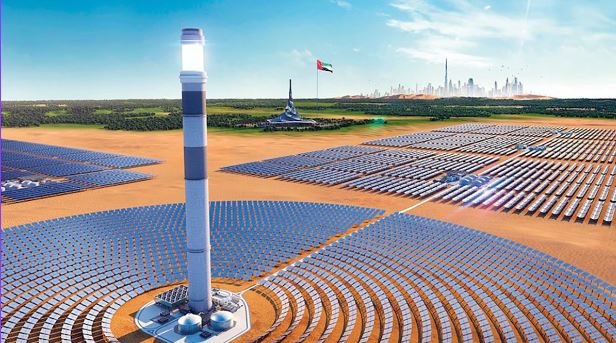
Benefits
The benefits drawn from implementing a solar tower include:
- Solar towers can be implemented to suit different energy demands from small trial projects to large scale installations.
- The capacity to integrate solar towers with other systems such as heat and power for instance is large. This allows utilization of excess thermal energy in undertaking other processes such as heating.
- The efficiency in thermal-to-electric conversion of solar towers is comparatively high when compared to other concentrating solar collectors. Thus, the receiver is capable of achieving high temperatures allowing more efficient transfer and generation of electricity.
- The energy generated by solar towers is classified as renewable and clean owing to its lack of greenhouse emissions. Consequently, it is environmentally friendly as opposed to other conventional methods like coal power generation that’re characterized by large carbon footprints.
- The land use when employing solar towers is typically lower than say solar farms utilizing photovoltaic panels. The footprint occupied by the tower structure is relatively small allowing multiple land use.
- You can incorporate storage systems for thermal energy with solar towers allowing production of electricity in the absence of sunlight. This provides grid stability ensuring there’s no instance where power is not generated owing to natural circumstances.
Limitations
The solar tower is subject to the following drawbacks:
- Designing and constructing a solar tower is not a straightforward engagement requiring complex engineering to set up.
- Installing a solar tower is a capital intensive project compared to other solar collector systems especially when conducted at large scale.
- The efficiency and performance of solar towers depends on the availability of sunlight limiting where you can use them.
Applications
Solar towers find several applications in the field of renewable energy with the following key applications:
- Industrial processes requiring high temperature heat such as desalination and steam production can utilize solar towers.
- Solar towers are a dependable option for off grid areas that are remote with inadequate alternative sources of power.
- Solar towers are configured with other power generating infrastructure to make hybrid power systems.
- Solar towers find use in implementation of large-scale concentrated solar plants used for electricity generation from thermal energy.
- These solar collectors can provide storage for excess thermal energy allowing continuous power generation in the absence of sunlight.
How Non-Pressure Solar Collector compare to High Pressure Solar Collector
The non-pressure and high-pressure solar collector differ in their design and operation as follows:
Non-Pressure Solar Collector
A non-pressure solar water heater operates using the natural convection principle featuring an open-loop system directly connecting the solar collector and storage tank. It does not use circulation loops or pumps operating at atmospheric pressure.
Non-pressure solar collectors feature a simpler design than high-pressure collectors implementing a flat plate or evacuated tube collector with an integrated storage tank. Positioning the storage tank above the collector subjects the flow to natural convection.
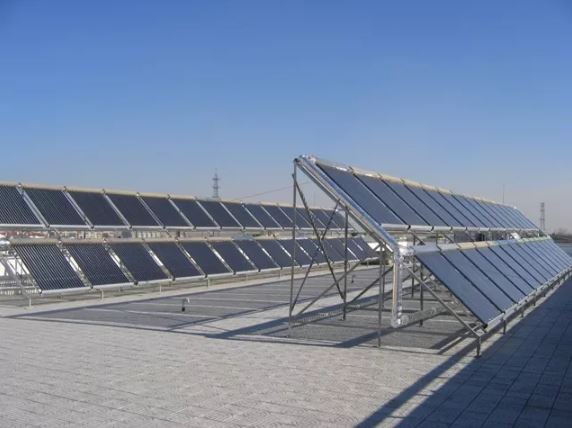
High-Pressure Solar Collector
A high-pressure water heater system operates at elevated pressures utilizing a closed-loop system implementing pumps heat transfer fluid circulation. It typically features a more complex direct flow design utilizing evacuated tube collectors alongside other components like regulators and pumps.
The heat transfer fluid is circulated via pumps which transport the heat transfer to an exchanger for conversion into useful form. The pressurized system, usually ranging into tens of bars, makes it possible to achieve precise control over the process of heat transfer.
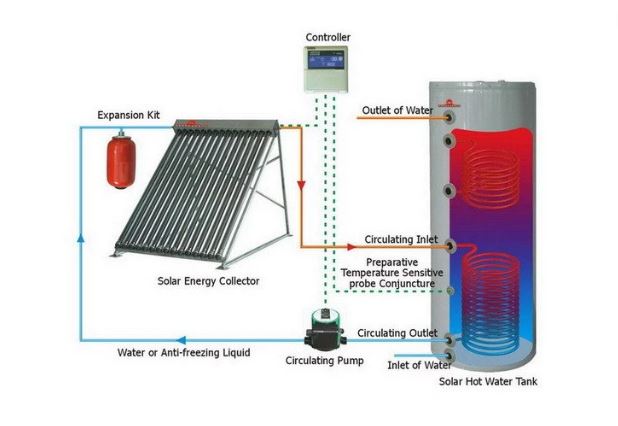
How to Choose Best Solar Thermal Collector
Choosing the best solar thermal collector for your specific needs requires careful consideration of several factors. Here’s how you can ensure that you select the most suitable solar thermal collector:
Identify Needs
Solar collectors have different capabilities and applications requiring you to identify specific needs. They have different working temperature range and heat transfer capacity for use such as water heating or space heating.
Research on Types
There are different types of solar collectors including concentrating and non-concentrating which exhibit different performance levels. It is essential you understand their working, benefits, limitations and best application scenarios to match with your needs.
Assess Efficiency
The efficiency of a solar collector determines its performance in terms of conversion of solar energy into useful heat. Go for solar collectors with high thermal efficiency as they make the most of any available sunlight especially in cloudy or cold conditions.
Cost Effectiveness
Evaluate the collector’s cost-effectiveness by considering the initial cost of setting up and the energy savings accrued in the long run. Determine how long it will take to recoup your investment and thus the solar collector’s financial viability.
Assess Space Availability
While there are several types of solar collectors, it goes to say the spatial requirements of each differ. Whether using rooftop space or open ground space for your solar collector, ensure it is adequate for successful installation.
Performance vs Conditions
Climate conditions influence solar collector performance with equatorial regions for instance having more sunlight compared to the tropics. Solar collectors perform best where there’s considerable exposure to sunlight.
Maintenance
Assess the maintenance needs of the solar collector by considering factors cleaning, accessibility, and lifespan. Choose collectors with sturdy construction and fashioned from corrosion resistant material whose design sustains long-term use.
Seek Expert Advice
Consult with professionals with experience in solar collectors as they can offer valuable insights and recommendations. By considering your needs and application demands, they can recommend the most suitable collector.
Check Manufacturer Reputation
There are many manufactures of solar collectors producing similar equipment with different parameters and capabilities. Purchase from manufacturers with a long and proven history of delivering quality products.
Determining Solar Collector Efficiency
A solar collector’s thermal efficiency describes the ratio of collector fluid’s useful heat to the total incident solar radiation over the collector’s gross surface area.
It is expressed thus;
![]()
Where,
q = useful heat gain
A = gross surface area of the collector
Isolar = total incident solar radiation, where Isolar > 0.
How Solar Panel Vs Solar Collector Compare
Both solar panels and solar collectors harness solar energy but differ in design and functionality as follows:
Solar Panels
Also called photovoltaic panels, they are usually flat with a glass shield to safeguard the cells. They consist multiple semiconductor solar cells used in the absorption of sunlight that is directly converted into electricity through the photovoltaic effect.
Solar panels find primary use in both small scale and large scale electricity generation like powering residences and solar farms. These panels have lower efficiencies than collectors and can store generated electricity in batteries.
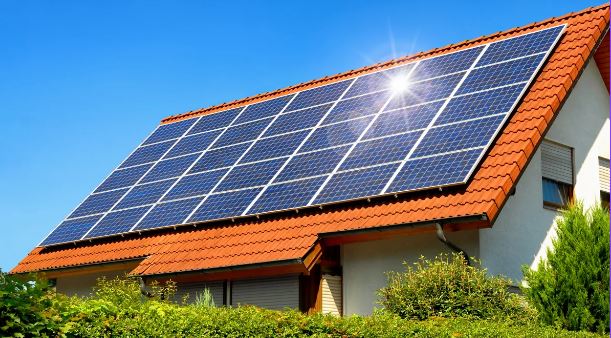
Solar Collectors
Solar collectors capture solar thermal energy by utilizing heat-absorbing surfaces that transfer the thermal energy to a transfer fluid. The heat transfer fluid is thereafter subjected to a technology form like heat exchanger where it is converted into useful energy.
Solar collectors are primarily utilized for thermal applications such as water heating, process heating as well as thermal power plants. They achieve higher efficiency levels compared to solar panels and can store excess thermal energy in uniquely designed storage systems.
Important Design Parameters in Solar Thermal Collector
Several design parameters are integral to the performance and efficiency of a solar thermal collector. As such consideration of these parameters is necessary in the design phase.
They include:
Collector Surface Area
The collector surface area determines the how much solar radiation can be captured for conversion into heat. Where you have a larger surface area, you achieve a higher energy output. It is, however, dependent on factors such as application, available space and cost.
Glazing Material
The glazing is the transparent cover that encloses the absorber protecting it and reducing heat losses through environmental exposure. Materials commonly used for glazing are plastics with high transparency and tempered glass and are highly influential to performance.
Absorber Material
The absorber material is vital for the absorption of solar radiation and conversion into heat energy. Metals such as copper and aluminium are utilized as absorber materials and can include selective coatings to enhance absorption and minimize heat loss.
Insulation
Insulation reduces heat losses thus improving collector efficiency with factors such as type and thickness affecting it. Foam or fiberglass are utilized as insulation materials usually placed around the collector’s back and sides.
Tube Design and Flow Path
An optimized design of the fluid channel ensures pressures losses are low and heat distribution is uniform across the absorber surface. The path of flow of the heat transfer fluid flow in the collector influences the efficiency in heat transfer.
Operating Conditions
When designing a solar collector consider the climate and operating conditions of the area of installation. Ambient temperature variations, solar radiation levels, wind speed, and cloud shading can affect collector performance.
Heat Transfer Fluid
Some common transfer fluids are molten salts and water whose choice is dependent on desired working temperature range and application. A good transfer fluid has decent thermal properties, resistance to corrosion, and suitable freezing and boiling points given the operating conditions.
Tracking Mechanism
Specialized collector designs feature tracking mechanism to align the collector towards the sun ensuring maximum capture of solar radiation. Tracking systems can rely on the sun’s position in the sky (passive) or be automated via sensors and motors (active).
New Technological Advancements in Solar Collector Technology
Advancements in solar collector technology aim to improve efficiency and make these systems cost-effective and thus affordable. With growing environmental concerns, interventions are in place to increase acceptance of renewable energy alternatives such as solar collectors.
Some notable technological advancements in solar collector technology include:
Nanotechnology
The success of nanomaterials in other technological applications has stirred exploration on their possibility of use in solar collectors. Implementing nanostructured materials such as coatings in solar collectors can reduce reflection/thermal loss, improve solar capture and increase heat transfer.
Insulation Materials
Advancements being made in insulation materials are focused on ensuring little or no heat loss at all in solar collectors. High-performance insulation materials with improved moisture resistance and low thermal conductivity are being experimented in solar collectors to improve overall efficiency.
Absorber Coatings
Industrial research and development departments are focusing efforts to improve absorber coatings and positively influence solar absorption while reducing heat losses. Novel selective coatings with improved optical properties are being researched in this regard.
Heat Transfer Fluids
Novel heat transfer fluids featuring augmented thermal properties are being tested such as utilizing nanofluids. Some solar collectors are implementing phase change materials for transfer fluids to improve efficiency in heat transfer and superior storage of thermal energy.
Integrated Energy Storage
Integrating solar collectors with advanced thermal energy storage systems reduces energy wastage. Storage systems with larger capacities are being pioneered to keep systems online even in the absence or insufficiency of solar radiation.
Optical Designs
Solar collectors with advanced optical designs seek to optimize sunlight capture and concentration. Design improvements are focused on reducing losses from reflection and increasing capture of sunlight and concentration capability.
Hybrid Systems
Scientists and engineers are working on hybrid solar collector systems combining multiple technologies like photovoltaic-thermal collectors. Such systems can simultaneously perform functions like generation of thermal energy and electricity from single sourced solar energy.
Smart Control
Modern solar collector designs are being presented with advanced monitoring and control systems to improve energy management and optimize performance. Such systems will incorporate automation via sensors and data analytics to remotely monitor functions.
Uses of Solar Collector
There are several implementations of solar collectors in industries and domestic set ups. Some of the common uses of solar collectors are listed below:
Water Heating
It is one of the most popular applications of solar collectors finding use in households and both commercial and industrial settings. Households utilize hot water for baths while commercial settings such as hotels heat swimming pools in cold conditions.
Space Heating
Solar collectors are independently used for space heating or sometimes combined with other heating alternatives. Space heating is especially vital in colder climates such as winter providing heat for households and buildings.
Industrial Process Heating
Some industrial applications require heating such as baking and drying in food processing or melting in mineral refining. Solar collectors are capable of providing high-temperature heat to support these processes.
Cooling
Solar cooling systems can implement solar collectors in capturing heat for powering chillers. The harnessed thermal energy is used in generating cooling conditions sufficient for air conditioning or refrigeration purposes.
Power Generation
Advanced solar collectors like parabolic troughs or solar towers are used for electric generation in concentrated solar power plants. The collectors convert solar energy into heat absorbed by transfer fluids and used for steam generation that drive electricity producing turbines.
Desalination
Solar collectors utilize solar energy in evaporating saline or sea water in solar desalination systems separating out unwanted impurities and salts. The water vapour is cooled in a condensation process resulting in collection of fresh water.
Greenhouse Heating
Greenhouses require a highly regulated climate which can be achieved by implementing solar collectors. The thermal environment created by these collectors is especially useful in crop drying before harvesting.
Cooking
Solar cookers and ovens utilize solar collector systems in harnessing sunlight and converting it into heat used in in food preparation. Such cookers are typically used in off-grid areas such as far flung research stations with minimal alternatives.
Thermal Integration
Instead of completely doing away with a conventional heating system, you can integrate your system with a solar collector. This way, they supplement each other improving overall system efficiency and overdependence on a single system.
Conclusion
Solar collectors have contributed to energy efficiency, an increase in renewable energy utilization and subsequently reduced negative environmental impact. While there are diverse and growing uses of solar collectors, application is crucially dependent on availability of sunlight.
Consequently, efforts are underway to improve efficiency of solar collectors to increase the rate of heat transfer. Developing such solar collectors will ensure maximum solar energy capture in the event of scarce sunlight resource.




